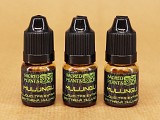Bark, Dry Extract 12:1, 60 Ml, 10 Gr from Peru (SKU 0927)
Cat’s Claw (Uncaria tomentosa), or Uña de Gato, is a sacred Amazonian vine long used by the Asháninka and other tribes for cleansing, protection, and resilience. This 12:1 hydroalcoholic extract condenses the strength of the bark into a fine, soluble powder. It can be taken directly by stirring ¼ teaspoon into a cup of hot water and sweetening with honey—the taste is naturally bitter, so smaller amounts make a milder drink. For a stronger preparation, dissolve half a teaspoon of extract into a tea made by simmering 2 teaspoons of bark powder in 1 liter of water. To explore the full history and ceremonial role of Cat’s Claw, see our complete article here.
Packed in 60 ml clear plastic pots containing 10 gr.
Cat’s Claw 12:1 Extract – Uña de Gato
Cat’s Claw (Uncaria tomentosa), known as Uña de Gato, is a climbing rainforest vine whose curved thorns give it its name. It grows in the tropical forests of South and Central America, reaching up to thirty meters high. The Asháninka of central Peru are most closely associated with its use, though the Aguaruna, Shipibo, Cashibo and Conibo also revere it. For more than two thousand years, these tribes have prepared decoctions of the bark in ceremonies of cleansing, protection, and restoration.
This 12:1 hydroalcoholic extract is made by carefully concentrating the active components of the vine into a fine, soluble powder. It captures the plant’s grounding and restorative qualities in a highly potent form, while reflecting both tradition and modern refinement.
Character and Use
The extract carries the same cleansing and protective character of the bark, but in much smaller amounts. It is easily dissolved in hot water and can be taken on its own or combined with a traditional bark tea.
Preparation
– For direct use, stir ¼ teaspoon of extract into a cup of hot water and sweeten with honey. The bitter taste is naturally strong, so lower dosages can be used for a milder drink.
– For a combined method, prepare a light Cat’s Claw tea by simmering 2 teaspoons of bark powder (available here) in 1 liter of water for 15–20 minutes, then dissolve about half a teaspoon of the extract into the tea. This harmonizes Indigenous preparation with modern extraction, yielding a concentrated infusion that honors the spirit of the vine.
To learn more about the full history, cultural significance, and ceremonial role of Cat’s Claw, please read our detailed article here.
Other names: Uncaria tomentosa, Una de Gato, Uña de Gato, Paraguayo, Garabato, Garbato Casha, Samento, Toroñ, Tambor Huasca, Uña Huasca, Uña de Gavilan, Hawk's Claw, Saventaro.
This item is not allowed in the following countries:
Taiwan
This natural product is offered for its ethnographic and historical value and is delivered with no expressed or implied fitness for a specific purpose. It is simply a raw botanical specimen, or a scientific sample. The information provided is purely meant for historical, scientific and educational purposes and should never be interpreted as a recommendation for a specific use. The use and application of our product is at the customer's decision, responsibility and risk.
Read our Terms & Conditions for more details.




